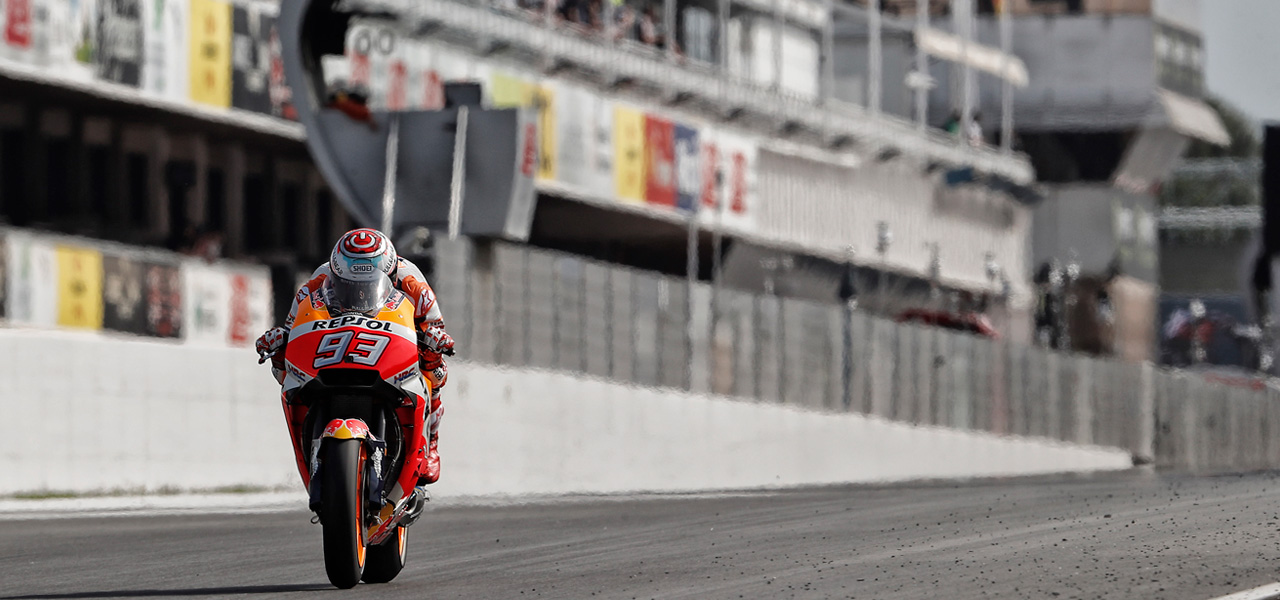During the 1992 Olympic Games in Barcelona, the circuit was the starting and finishing point for the 100 kilometres time trial cycling event.
We get onboard Marc Márquez’ Honda to give a tour of the Spanish circuit.
1) The Circuit de Barcelona-Catalunya was inaugurated on September 10th, 1991 and only 19 days later it hosted its first Formula 1 Grand Prix.
2) It celebrated its first Motorcycle World Championship GP in 1992, under the name of the European GP -a denomination that it maintained until 1995, when it was called the Catalan GP for the first time.
3) It is located in the municipality of Montmeló and replaced the circuit of Montjuïc, an urban layout that runs along the famous hill in Barcelona and which can still be seen today. That circuit hosted Motorcycle World Championship and Formula 1 rounds until the mid-1970s.
4) On the hill to the right of Turn 7 is La Moreneta, an old farmhouse that existed before the circuit was built and now houses its offices.
5) When it was designed, it was a pioneering track in Spain in the creation of service roads and in the location of Race Direction: On the first floor of the control tower, without direct vision on the track but instead using only monitors.
6) A total of 16 giant screens allow spectators to follow the race live from any stand.


7) Álex Crivillé won the 1999 race in the premier class, after crossing the finish line just 61 thousandths of a second ahead of his then Repsol Honda teammate Tadayuki Okada, who he passed on a thrilling last lap, and just over four seconds ahead of Gibernau, who completed an impressive team hat-trick..
8) At the end of the race, fans invaded the track to celebrate a victory that brought Crivillé closer to Spain’s first title in the premier class.
9) Located on the main straight, next to the exit of the pit lane, is a large scoreboard inspired by the one that exists at Indianapolis, showing the Top 10 and the number of laps remaining.
10) The Circuit de Barcelona-Catalunya offers fans an internal radio broadcast service of the race. It is available in both Spanish and Catalan.
11) Motorcycle riding is deeply rooted in Catalonia, and in the 1930s the first editions of the Barcelona Grand Prix were held at Montjuïc.
12) The tradition was consolidated by the importance of the motorcycle sector, which survived until the 1980s. Precursors like Villalbí, SG and Patria opened the way for Sanglas, Montesa, Bultaco, Ossa, Clua, Rieju and Derbi, and for more than a hundred small manufacturers that arose during the economic autarchy of the beginnings of Francoism.


13) As at many circuits around the world, track officers are volunteers enrolled in a database of around 900 people. They must be over 18 years old and pass an entrance exam, having studied the Race Officer’s Handbook.
14) During the 1992 Olympic Games in Barcelona, the circuit was the starting and finishing point for the 100 kilometres time trial cycling event.
15) The main grandstand, which holds 5,000 spectators, doubled its capacity in 2002, following a redesign carried out by Hermann Tilke -a German engineer who designed tracks such as COTA, MotorLand Aragon and Sepang.
16) The BiCircuit Festival is an event that brings together a multitude of activities related to cycling: from the 24 hours on a bike to the Brompton World Cup, in which participants compete on folding bikes and wear suits, as if they were going to the office. Last year it could not be held due to COVID-19, but this year it will be held again in July.


 Join Us
Join Us  Join Us
Join Us 